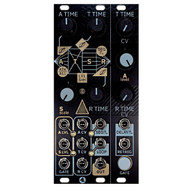Starling — ATSR
by Sam Chittenden
Starling makes a line of Eurorack modules named Via that all utilize a shared hardware platform. This setup allows a single piece of hardware to be transmogrified into one of several available modules on the Via platform simply by swapping out a faceplate and flashing a different firmware. Featuring digital control over analog circuitry, the available modules span a wide range of functionality, from oscillators to waveshapers, function generators to gate sequencers, and more. Each Via module brings new twists and fresh perspectives to more traditional functions and the ATSR module is no exception.
As its name implies the ATSR is a close cousin to a traditional voltage controlled ADSR envelope generator. Where it differs—and what a difference it makes—is in the fact that the ATSR can transition from any attack voltage to any sustain voltage over a continuously variable crossfade time. The key is in the word any. In a traditional ADSR, the envelope signal traverses from 0V up to a positive attack level and then decays to a sustain level that is even with or below [but never less than 0V] the level of the voltage in the attack stage. With the ATSR the attack and sustain voltages can fall anywhere within the module's -10V to +10V range. The T[ransition] stage will smoothly crossfade between the A[ttack] and S[ustain] voltages over a specified amount of time. So you can trigger an envelope that immediately falls to -3V before slowly rising to +8V at the sustain stage or one that rises to +6V before plummeting to a -8V sustain level. The attack, transition, and release stages can be set to follow one of four defined curves: exponential, linear, sinusoidal, logarithmic. There are inputs for CV over the attack, transition, and [R]elease stage times of the envelope [along with associated attenuators and additionally, the attack CV can be set to control the attack stage time or to control the time for the entire envelope.
The ATSR has three gate outputs which are triggered at various points in the envelope progression. The Seg[ment] gate can be selected to go high for the duration of any one of the four segments of the envelope. Delay is a copy of the Gate input [or manual gate] but its onset is delayed by time equal to the combination of the A and T stage times. Effectively the delay gate goes high when the A and T stages have completed [as long as the gate input is held open long enough to complete the T stage]. Feeding an enveloped LFO into the sustain segment makes for a great tremolo effect. Triggering the opening of the LFO's envelope from the ATSR's Seg gate out makes it easy to have everything synced up and to constrain the tremolo effect to just the sustain portion of the envelope.
With full voltage control over both the attack and sustain levels it is possible to create envelope shapes that range from complex to chaotic, depending on what your input is. You can select between two different behaviors-LVL and S+H for these inputs. S+H is a sample and hold which will sample the A level input at the onset of both the attack and sustain portions of the envelope and will sample the S level input at the beginning of the T stage. Great for dialing in variable and shifting envelope topographies. With LVL selected the voltage at each level input is continuously monitored, passing through the signal during each respective stage to the output. In this way the ATSR can be utilized sort of like a crossfading, wavemorphing VCA! For example, putting a sine wave into the A level input and a pulse wave into the S level input will output the sine wave during the attack stage, morph from the sine to the pulse over the time stage, and finally remain at the pulse wave during the sustain stage. The volume of the output will follow the envelope shape. Wavemorphing VCA? Sweet!
By utilizing some straightforward self-patching the ATSR can also generate some fun and interesting LFO shapes as well. Patching from the loop gate out to the gate input will loop over the entire envelope shape. A more standard LFO can be set up by utilizing both the loop gate into the gate in as well as patching the ATSR's delay gate to the retrig in. This will loop continuously from the A level to the S level via the T slope. Experimenting with sending different inputs to the The A and S level as well as to the various CV ins can also create further unique and evolving LFOs.
Because of the adaptable nature of the Via platform [using the same standardized layout for the various incarnations] the ATSR interface can seem a little oddly laid out at first. That said, given the inherent flexibility of the platform itself, and the fact that—even if oddly placed—the controls are easy to navigate, it more than makes up for any initial awkwardness in ergonomics.
If you're looking for a module that makes everything from run of the mill envelopes and basic LFOs to crazy looped waveshapes and wild and warping LFOs, the ATSR is right up your alley. For what seems on the surface to be a simple envelope generator, the ATSR—after a few minutes of use—really reveals itself to be much more. The ability to set the attack and sustain voltages to both positive and negative values gives the ATSR the ability to become a fantastic source of modulation in your system and despite its deep potential for complex shapes and wild modulation, is simple and easy to use. Highly recommended!
+12V/-12V: 110mA/50mA
Price: $269


